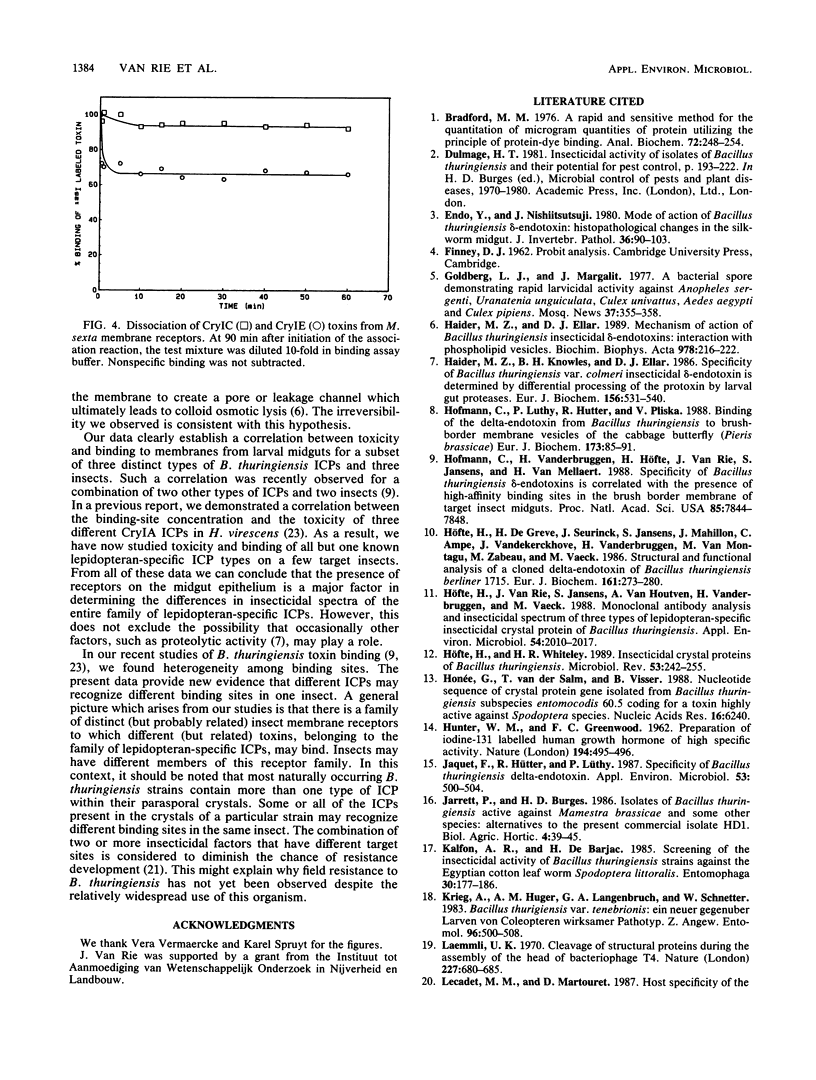Abstract
To investigate the biochemical basis of the differences in the insecticidal spectrum of Bacillus thuringiensis insecticidal crystal proteins (ICPs), we performed membrane binding and toxicity assays with three different ICPs and three lepidopteran species. The three ICPs have different toxicity patterns in the three selected target species. Binding studies with these 125I-labeled ICPs revealed high-affinity saturable binding to brush border membrane vesicles of the sensitive species. ICPs with no toxicity against a given species did not bind saturably to vesicles of that species. Together with previous data that showed a correlation between toxicity and ICP binding, our data support the statement that differences in midgut ICP receptors are a major determinant of differences in the insecticidal spectrum of the entire lepidopteran-specific ICP family. Receptor site heterogeneity in the insect midgut occurs frequently and results in sensitivity to more than one type of ICP.
Full text
PDF







Images in this article
Selected References
These references are in PubMed. This may not be the complete list of references from this article.
- Bradford M. M. A rapid and sensitive method for the quantitation of microgram quantities of protein utilizing the principle of protein-dye binding. Anal Biochem. 1976 May 7;72:248–254. doi: 10.1006/abio.1976.9999. [DOI] [PubMed] [Google Scholar]
- HUNTER W. M., GREENWOOD F. C. Preparation of iodine-131 labelled human growth hormone of high specific activity. Nature. 1962 May 5;194:495–496. doi: 10.1038/194495a0. [DOI] [PubMed] [Google Scholar]
- Haider M. Z., Ellar D. J. Mechanism of action of Bacillus thuringiensis insecticidal delta-endotoxin: interaction with phospholipid vesicles. Biochim Biophys Acta. 1989 Jan 30;978(2):216–222. doi: 10.1016/0005-2736(89)90118-1. [DOI] [PubMed] [Google Scholar]
- Haider M. Z., Knowles B. H., Ellar D. J. Specificity of Bacillus thuringiensis var. colmeri insecticidal delta-endotoxin is determined by differential proteolytic processing of the protoxin by larval gut proteases. Eur J Biochem. 1986 May 2;156(3):531–540. doi: 10.1111/j.1432-1033.1986.tb09612.x. [DOI] [PubMed] [Google Scholar]
- Hofmann C., Lüthy P., Hütter R., Pliska V. Binding of the delta endotoxin from Bacillus thuringiensis to brush-border membrane vesicles of the cabbage butterfly (Pieris brassicae). Eur J Biochem. 1988 Apr 5;173(1):85–91. doi: 10.1111/j.1432-1033.1988.tb13970.x. [DOI] [PubMed] [Google Scholar]
- Hofmann C., Vanderbruggen H., Höfte H., Van Rie J., Jansens S., Van Mellaert H. Specificity of Bacillus thuringiensis delta-endotoxins is correlated with the presence of high-affinity binding sites in the brush border membrane of target insect midguts. Proc Natl Acad Sci U S A. 1988 Nov;85(21):7844–7848. doi: 10.1073/pnas.85.21.7844. [DOI] [PMC free article] [PubMed] [Google Scholar]
- Honée G., van der Salm T., Visser B. Nucleotide sequence of crystal protein gene isolated from B. thuringiensis subspecies entomocidus 60.5 coding for a toxin highly active against Spodoptera species. Nucleic Acids Res. 1988 Jul 11;16(13):6240–6240. doi: 10.1093/nar/16.13.6240. [DOI] [PMC free article] [PubMed] [Google Scholar]
- Höfte H., Van Rie J., Jansens S., Van Houtven A., Vanderbruggen H., Vaeck M. Monoclonal Antibody Analysis and Insecticidal Spectrum of Three Types of Lepidopteran-Specific Insecticidal Crystal Proteins of Bacillus thuringiensis. Appl Environ Microbiol. 1988 Aug;54(8):2010–2017. doi: 10.1128/aem.54.8.2010-2017.1988. [DOI] [PMC free article] [PubMed] [Google Scholar]
- Höfte H., Whiteley H. R. Insecticidal crystal proteins of Bacillus thuringiensis. Microbiol Rev. 1989 Jun;53(2):242–255. doi: 10.1128/mr.53.2.242-255.1989. [DOI] [PMC free article] [PubMed] [Google Scholar]
- Höfte H., de Greve H., Seurinck J., Jansens S., Mahillon J., Ampe C., Vandekerckhove J., Vanderbruggen H., van Montagu M., Zabeau M. Structural and functional analysis of a cloned delta endotoxin of Bacillus thuringiensis berliner 1715. Eur J Biochem. 1986 Dec 1;161(2):273–280. doi: 10.1111/j.1432-1033.1986.tb10443.x. [DOI] [PubMed] [Google Scholar]
- Jaquet F., Hütter R., Lüthy P. Specificity of Bacillus thuringiensis Delta-Endotoxin. Appl Environ Microbiol. 1987 Mar;53(3):500–504. doi: 10.1128/aem.53.3.500-504.1987. [DOI] [PMC free article] [PubMed] [Google Scholar]
- Laemmli U. K. Cleavage of structural proteins during the assembly of the head of bacteriophage T4. Nature. 1970 Aug 15;227(5259):680–685. doi: 10.1038/227680a0. [DOI] [PubMed] [Google Scholar]
- Mani G. S. Evolution of resistance in the presence of two insecticides. Genetics. 1985 Apr;109(4):761–783. doi: 10.1093/genetics/109.4.761. [DOI] [PMC free article] [PubMed] [Google Scholar]
- Munson P. J., Rodbard D. Ligand: a versatile computerized approach for characterization of ligand-binding systems. Anal Biochem. 1980 Sep 1;107(1):220–239. doi: 10.1016/0003-2697(80)90515-1. [DOI] [PubMed] [Google Scholar]
- Van Rie J., Jansens S., Höfte H., Degheele D., Van Mellaert H. Specificity of Bacillus thuringiensis delta-endotoxins. Importance of specific receptors on the brush border membrane of the mid-gut of target insects. Eur J Biochem. 1989 Dec 8;186(1-2):239–247. doi: 10.1111/j.1432-1033.1989.tb15201.x. [DOI] [PubMed] [Google Scholar]



